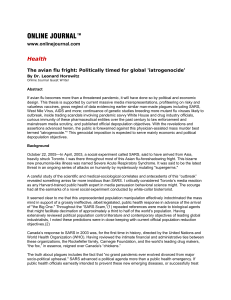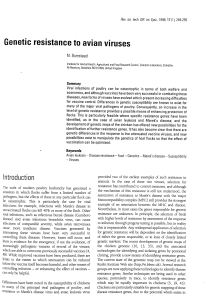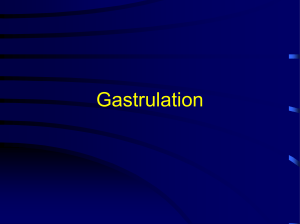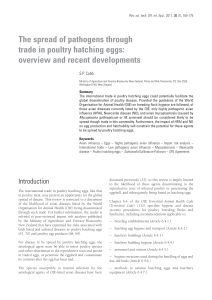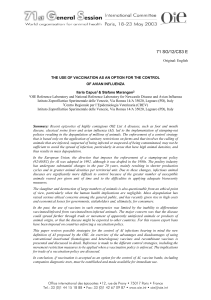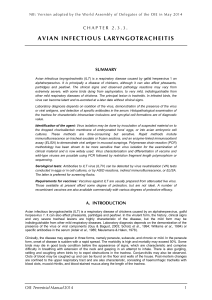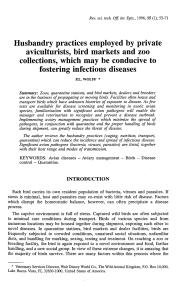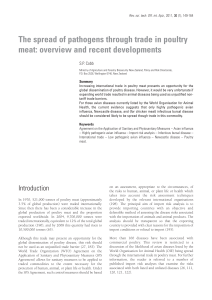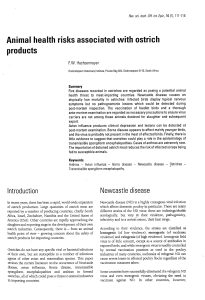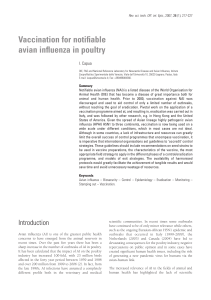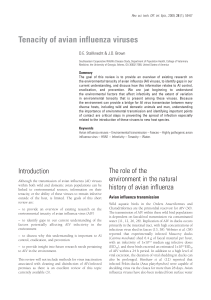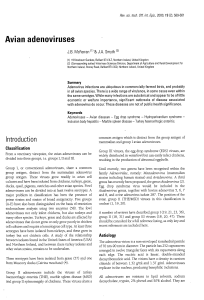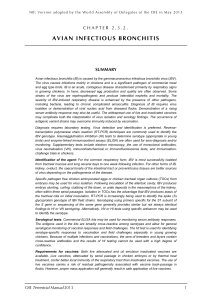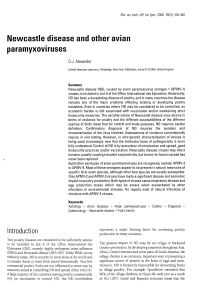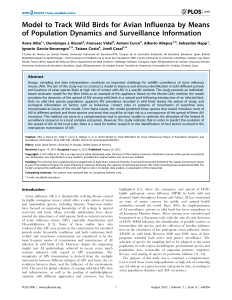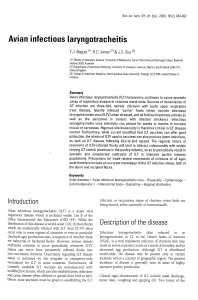D6952.PDF
publicité
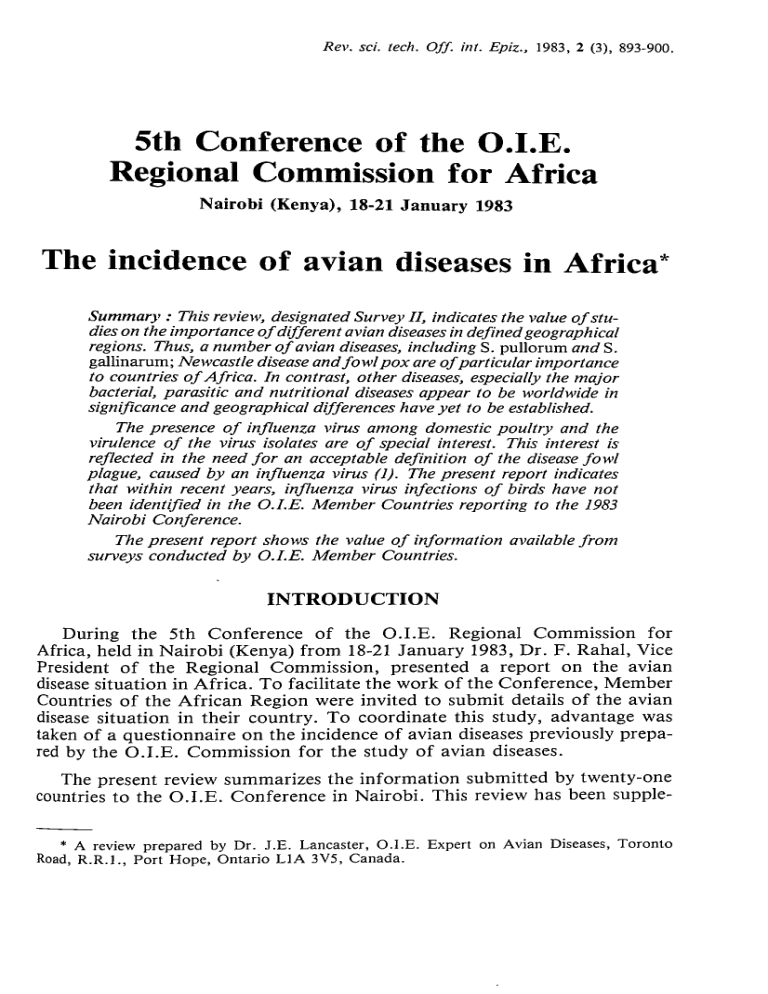
Rev. sci. tech. Off. int. Epiz., 1983, 2 (3), 893-900. 5th Conference of the O.I.E. Regional Commission for Africa Nairobi (Kenya), 18-21 January 1983 The incidence of avian diseases in Africa* Summary : This review, designated Survey II, indicates the value of stu­ dies on the importance of different avian diseases in defined geographical regions. Thus, a number of avian diseases, including S. pullorum and S. gallinarum; Newcastle disease and fowl pox are of particular importance to countries of Africa. In contrast, other diseases, especially the major bacterial, parasitic and nutritional diseases appear to be worldwide in significance and geographical differences have yet to be established. The presence of influenza virus among domestic poultry and the virulence of the virus isolates are of special interest. This interest is reflected in the need for an acceptable definition of the disease fowl plague, caused by an influenza virus (1). The present report indicates that within recent years, influenza virus infections of birds have not been identified in the O.I.E. Member Countries reporting to the 1983 Nairobi Conference. The present report shows the value of information available from surveys conducted by O.I.E. Member Countries. INTRODUCTION During the 5th Conference of the O.I.E. Regional Commission for Africa, held in Nairobi (Kenya) from 18-21 January 1983, Dr. F. Rahal, Vice President of the Regional Commission, presented a report on the avian disease situation in Africa. To facilitate the work of the Conference, Member Countries of the African Region were invited to submit details of the avian disease situation in their country. To coordinate this study, advantage was taken of a questionnaire on the incidence of avian diseases previously prepa­ red by the O . I . E . Commission for the study of avian diseases. The present review summarizes the information submitted by twenty-one countries to the O . I . E . Conference in Nairobi. This review has been supple- * A review prepared by Dr. J.E. Lancaster, O.I.E. Expert on Avian Diseases, Toronto Road, R.R.I., Port H o p e , Ontario L I A 3V5, Canada. — 894 — merited with data from the previous survey, designated Survey I, conducted by the O.I.E. INFORMATION AVAILABLE The Questionnaire on the Incidence of Avian Diseases was distributed to O.I.E. Member Countries during 1981. A n analysis of the information recei­ ved from forty-two Countries was presented to the 50th General Session (May 1982). This information (designated Survey I) was published in the O.I.E. Review (1). That publication included information on avian diseases from eight Countries in Africa. At the 1983 Nairobi Conference, twenty-one Countries in Africa presen­ ted reports based on the O.I.E. Questionnaire. These reports are designated Survey II. The reporting Countries comprised the following three groups : — six countries reported the same information previously included in Survey I. These were Botswana, Ivory Coast, Kenya, Libya, South Africa and Zimbabwe; — two countries reported a change in the avian disease picture between Surveys I and II. These were Cameroon and Madagascar. For these two countries, the most recent information has been used in this review; — thirteen countries completed the questionnaire for the first time. These were Algeria, Chad, Ethiopia, Ghana, Mali, Morocco, Niger, Nigeria, Tan­ zania, Togo, Uganda, the Upper Volta and Zambia. GEOGRAPHICAL DISTRIBUTION The geographical location of the Member Countries replying to both sur­ veys has enabled these Countries to be designated as being either north or south of latitude 10°N. This distribution placed the following countries in the northern sector : Algeria, Chad, Libya, Mali, Morocco, Niger and Upper Volta. Those in the southern sector are : Botswana, C a m e r o o n , Ethiopia, Ghana, Ivory Coast, Kenya, Madagascar, Nigeria, South Africa, Tanzania, Togo, Uganda, Zambia and Zimbabwe. RESULTS The results are shown in Tables I and la, in a manner comparable with the previous survey (Survey I) (1). When compared with the previous Survey I, it will be seen that the same bacterial diseases represent problems in Africa as in other geographical regions of the world. However, there is a change in emphasis when compared with the previous Survey I. T h u s , Salmonella pullorum and S. gallinarum are — 895 — important diseases in many countries of Africa. In contrast, mycoplasmosis is of lesser significance. It will be seen from Tables II and IIa that of the twenty countries repor­ ting the presence of Newcastle disease, eighteen countries reported this disease in category one of importance, indicating the overall significance of this disease. In Survey I, which was worldwide in scope, Newcastle disease was the second major virus disease. This was due to the low incidence of this disease in North America and Europe. Fowl pox, although widespread in Africa, was placed in categories two and three of importance. Table IIa shows bursal disease and important bacterial in the geographical differences in the geographical distribution of infectious Marek's disease together with lymphoid leukosis. The diseases (Table la) did not show such marked differences distribution. Tables III and IlIa show the importance of coccidiosis in Africa and also the wide distribution of helminths. Thus, the picture in Africa in respect of coccidiosis and helminths is the same as that shown by Survey I. This empha­ sizes the worldwide importance of these two internal parasites. Tables IV and IVa highlight the importance of nutritional diseases in all areas of Africa and reflect the worldwide incidence. In Survey I, management was significant in poultry production in both Africa and North America. The O . I . E . Questionnaire requested Countries to name the diseases which were becoming increasingly important. These have been termed "emerging diseases" and are summarized in Table V. It will be seen from Table V that Newcastle disease is not only the most important virus disease at the present time (Table II) but is also a disease which is becoming increasingly important. Similarly, among the parasitic diseases, coccidiosis is of primary importance, but is also a disease of increa­ sing importance. It is of interest to note that of the four emerging diseases listed in Table V of this survey (Survey II), only mycoplasmosis is common to the list of emer­ ging diseases as recorded on a worldwide basis (Table V, Survey I). Thus, the emerging avian diseases of Africa present a different picture to the worldwide situation. In Survey I, Table V (1), the isolation of avian influenza A viruses or the detection of antibodies against these viruses were reported in eleven different Countries. The present survey (Survey II) indicates that influenza virus infec­ tion was not present in any African country reporting to the Nairobi Confe­ rence (1983). * REFERENCE 1. O.I.E. Commission for the Study of Avian Diseases (1982). — Rev. sci. tech. Off. int. Epiz., 1 (3), 855, 863, 871. — 896 — TABLE I Order of importance of bacterial diseases within a country. Importance within a country Bacterial diseases S. pullorum and S. gallinarum Pasteurellosis Colibacillosis Salmonellosis Mycoplasmosis Bacterial enteritis Infectious coryza Staphylococcosis Tuberculosis Total 1 2 3 10 2 3 3 2 1 1 0 0 1 5 5 2 5 0 1 0 0 0 1 2 4 0 1 0 2 1 11 8 10 9 7 2 2 2 1 T A B L E la Geographic distribution of bacterial diseases within countries. Bacterial diseases S. pullorum and S. gallinarum Pasteurellosis Colibacillosis Salmonellosis Mycoplasmosis Northern sector (7 countries)* Southern sector (14 countries)* 4 4 3 4 2 7 4 7 5 5 * The number represents the number of countries reporting the disease. — 897 — T A B L E II Order of importance of virus diseases within a country. Importance within a country Virus diseases Newcastle disease Fowl pox Infectious bursal disease Marek's disease and lymphoid leukosis Infectious bronchitis Avian encephalomyelitis Infectious laryngotracheitis Total 18 0 3 2 11 1 0 5 6 20 16 10 1 0 0 3 3 0 3 1 1 7 4 1 0 0 1 1 T A B L E Ha Geographic distribution of virus diseases within countries. Virus diseases Newcastle disease Fowl pox Infectious bursal disease Marek's disease and lymphoid leukosis Infectious bronchitis Northern sector (7 countries)* Southern sector (14 countries)* 7 7 6 13 9 4 0 1 7 3 * The number represents the number of countries reporting the disease. — 898 — T A B L E III Order of importance of parasitic diseases within a country. Importance within a country Parasitic diseases Coccidiosis Helminths* External parasites Histomoniasis Spirochaetosis Syngamus Tetrameres * Helminths includes Ascaridia and Total 1 2 3 16 4 0 0 0 0 0 3 12 3 0 1 0 0 0 1 5 2 0 1 2 19 17 8 2 1 1 2 Capillana. T A B L E IIIa Geographic distribution of parasitic diseases within countries. Parasitic diseases Coccidiosis Helminths External parasites Northern sector (7 countries)* Southern sector (14 countries) * 6 5 2 13 12 6 * The number represents the number of countries reporting the disease. — 899 — T A B L E IV Order of importance of non-infectious diseases within a country. Importance within a country Non-infectious diseases Nutritional Management Metabolic Leg weakness Mycotoxicosis Total 1 2 3 14 2 2 0 0 4 6 0 0 1 0 0 1 1 0 TABLE 18 8 3 1 1 IVa Geographic distribution of non-infectious diseases within countries. „. Non-infectious diseases Nutritional Management Metabolic Northern sector * c o u n t r i e s ) 6 4 1 Southern sector countries)* ( 1 4 12 4 2 * The number represents the number of countries reporting non-infectious diseases. — 900 — TABLE V Geographic distribution of emerging diseases. Emerging diseases Coccidiosis Newcastle disease Marek's disease and lymphoid leukosis Mycoplasmosis Northern sector (7 countries)* Southern sector (14 countries)* 3 3 3 4 1 2 4 3 * The number represents the number o f countries reporting the disease.


